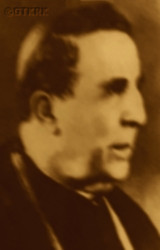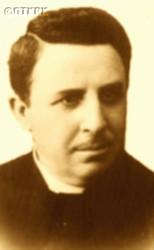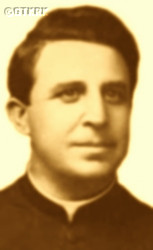Roman Catholic
St Sigismund parish
05-507 Słomczyn
85 Wiślana Str.
Konstancin deanery
Warsaw archdiocese, Poland
full list:
displayClick to display full list

searchClick to search full list by categories
wyświetlKliknij by wyświetlić pełną listę po polsku

szukajKliknij by przeszukać listę wg kategorii po polsku

Martyrology of the clergy — Poland
XX century (1914 – 1989)
personal data
surname
GLASER
forename(s)
Mark (pl. Marek)
forename(s)
versions/aliases
Marcus
function
bishop
creed
Latin (Roman Catholic) Church RCmore on
en.wikipedia.org
[access: 2014.09.21]
diocese / province
Iassy diocesemore on
en.wikipedia.org
[access: 2018.09.02]
Tiraspol diocesemore on
en.wikipedia.org
[access: 2014.11.14]
academic distinctions
Doctor of Philosophy
Doctor of Theology
honorary titles
pontifical prelatemore on
pontifical prelate
(1930)
Papal chamberlainmore on
Papal chamberlain
(1924)
nationality
German
date and place
of death
25.05.1950

Iașitoday: Iași Cou., Romania
more on
en.wikipedia.org
[access: 2022.02.04]
details of death
In recognition for services to Poles in his Kishinev parish rewarded by Poland with Polonia Restituta order.
During World War II started by German and Russian invasion of Poland in 09.1939, after invasion of Moldova in 06.1940 by the Russians, moved to Romania, to Iassy.
In 1942 nominated head of Catholic mission in Transnistria Governorate with capital in Odessa, formed by Germans nad Romanians and formally run by the latter.
Ministered almost exclusively to the Poles living there.
Soon was in dispute with German Army Wehrmacht and SS representatives over prohibition of all Catholic activities.
After German and Romanian defeat in war with Russian on the eastern front left on 23.03.1944 Odessa and moved west, beyond Prut river, to Romania proper.
After start of Russian occupation Russians twice refused — in 04.1945 and 06.1945 — his recognition as a bishop of Iassy diocese.
Repeatedly interrogated by the Russians.
After arrest in 06.1949 of a new Iassy diocese bishop, Bp Durcovivi, again took over the administration of the diocese.
Perished during one of the interrogation by the Romanian branch of Russian genocidal MGB(NKVD) — according to some sources heavily beaten up — officially though from „heart attack”.
cause of death
extermination
perpetrators
Russians/Romanians
sites and events
Ribbentrop‐MolotovClick to display the description, Pius XI's encyclicalsClick to display the description
date and place
of birth
25.04.1880

Landautoday: Shyrokolanivka, Stepove hrom., Mykolaiv rai., Mykolaiv obl., Ukraine
more on
en.wikipedia.org
[access: 2020.07.31]
parents
GLASER Joseph
🞲 10.01.1842, Landautoday: Shyrokolanivka, Stepove hrom., Mykolaiv rai., Mykolaiv obl., Ukraine
more on
en.wikipedia.org
[access: 2020.07.31] — 🕆 ?, ?

KUNZ Anne Mary
🞲 1845, Landautoday: Shyrokolanivka, Stepove hrom., Mykolaiv rai., Mykolaiv obl., Ukraine
more on
en.wikipedia.org
[access: 2020.07.31] — 🕆 ?, ?
presbyter (holy orders)
ordination
24.06.1905

Minsktoday: Minsk city reg., Belarus
more on
en.wikipedia.org
[access: 2020.07.31]
positions held
1943 – 1950
titular bishop — Caesaropolis RC diocese — appointment: on 10.06.1943; ordination: on 25.07.1943, in Bucharest
1948 – 1950
vicar general — Jassy RC diocese
1944 – 1948
apostolic administrator — Jassy RC diocese
1943 – 1944
apostolic inspector — Catholic Mission, southern Russia, Crimea and Caucasus
1941 – 1944
apostolic inspector — Odessatoday: Odessa urban hrom., Odessa rai., Odessa obl., Ukraine
more on
en.wikipedia.org
[access: 2022.02.04] ⋄ Catholic Mission, Transnistria Governorate
1940 – 1941
rector — Iașitoday: Iași Cou., Romania
more on
en.wikipedia.org
[access: 2022.02.04] ⋄ Theological Seminary ⋄ Jassy RC diocese
1917 – 1940
parish priest — Chișinăutoday: Moldova
more on
en.wikipedia.org
[access: 2022.02.04] ⋄ RC parish — with a large number of Polish parishioners, among whom he grew up
1905 – 1916
vice–rector — Saratovtoday: Saratov oblast, Russia
more on
en.wikipedia.org
[access: 2022.02.04] ⋄ philosophy and theology, Theological Seminary — also: lecturer
1905 – 1916
teacher — Saratovtoday: Saratov oblast, Russia
more on
en.wikipedia.org
[access: 2022.02.04] ⋄ Minor Theological Seminary
1900 – 1905
PhD student — Rometoday: Rome prov., Lazio reg., Italy
more on
en.wikipedia.org
[access: 2021.12.18] ⋄ philosophy and theology, Pontifical Roman German and Hungarian College (Lat. Pontificium Collegium Germanicum et Hungaricum de Urbe), known as „Collegium Germanicum” — under pseud. Markus Frey (due to Russian ban on foreign studies)
1897 – 1900
student — Saratovtoday: Saratov oblast, Russia
more on
en.wikipedia.org
[access: 2022.02.04] ⋄ philosophy and theology, Theological Seminary
sites and events
descriptions
Ribbentrop‐Molotov: Genocidal Russian‐German alliance pact between Russian leader Joseph Stalin and German leader Adolf Hitler signed on 23.08.1939 in Moscow by respective foreign ministers, Mr. Vyacheslav Molotov for Russia and Joachim von Ribbentrop for Germany. The pact sanctioned and was the direct cause of joint Russian and German invasion of Poland and the outbreak of the World War II in 09.1939. In a political sense, the pact was an attempt to restore the status quo ante before 1914, with one exception, namely the „commercial” exchange of the so‐called „Kingdom of Poland”, which in 1914 was part of the Russian Empire, fore Eastern Galicia (today's western Ukraine), in 1914 belonging to the Austro‐Hungarian Empire. Galicia, including Lviv, was to be taken over by the Russians, the „Kingdom of Poland” — under the name of the General Governorate — Germany. The resultant „war was one of the greatest calamities and dramas of humanity in history, for two atheistic and anti‐Christian ideologies — national and international socialism — rejected God and His fifth Decalogue commandment: Thou shall not kill!” (Abp Stanislav Gądecki, 01.09.2019). The decisions taken — backed up by the betrayal of the formal allies of Poland, France and Germany, which on 12.09.1939, at a joint conference in Abbeville, decided not to provide aid to attacked Poland and not to take military action against Germany (a clear breach of treaty obligations with Poland) — were on 28.09.1939 slightly altered and made more precise when a treaty on „German‐Russian boundaries and friendship” was agreed by the same murderous signatories. One of its findings was establishment of spheres of influence in Central and Eastern Europe and in consequence IV partition of Poland. In one of its secret annexes agreed, that: „the Signatories will not tolerate on its respective territories any Polish propaganda that affects the territory of the other Side. On their respective territories they will suppress all such propaganda and inform each other of the measures taken to accomplish it”. The agreements resulted in a series of meeting between two genocidal organization representing both sides — German Gestapo and Russian NKVD when coordination of efforts to exterminate Polish intelligentsia and Polish leading classes (in Germany called «Intelligenzaktion», in Russia took the form of Katyń massacres) where discussed. Resulted in deaths of hundreds of thousands of Polish intelligentsia, including thousands of priests presented here, and tens of millions of ordinary people,. The results of this Russian‐German pact lasted till 1989 and are still in evidence even today. (more on: en.wikipedia.orgClick to attempt to display webpage
[access: 2015.09.30])
Pius XI's encyclicals: Facing the creation of two totalitarian systems in Europe, which seemed to compete with each other, though there were more similarities than contradictions between them, Pope Pius XI issued in 03.1937 (within 5 days) two encyclicals. In the „Mit brennender Sorge” (Eng. „With Burning Concern”) published on 14.03.1938, condemned the national socialism prevailing in Germany. The Pope wrote: „Whoever, following the old Germanic‐pre‐Christian beliefs, puts various impersonal fate in the place of a personal God, denies the wisdom of God and Providence […], whoever exalts earthly values: race or nation, or state, or state system, representatives of state power or other fundamental values of human society, […] and makes them the highest standard of all values, including religious ones, and idolizes them, this one […] is far from true faith in God and from a worldview corresponding to such faith”. On 19.03.1937, published „Divini Redemptoris” (Eng. „Divine Redeemer”), in which criticized Russian communism, dialectical materialism and the class struggle theory. The Pope wrote: „Communism deprives man of freedom, and therefore the spiritual basis of all life norms. It deprives the human person of all his dignity and any moral support with which he could resist the onslaught of blind passions […] This is the new gospel that Bolshevik and godless communism preaches as a message of salvation and redemption of humanity”… Pius XI demanded that the established human law be subjected to the natural law of God , recommended the implementation of the ideal of a Christian state and society, and called on Catholics to resist. Two years later, National Socialist Germany and Communist Russia came together and started World War II. (more on: www.vatican.vaClick to attempt to display webpage
[access: 2023.05.28], www.vatican.vaClick to attempt to display webpage
[access: 2023.05.28])
sources
personal:
en.wikipedia.orgClick to attempt to display webpage
[access: 2018.09.02], www.catholic-hierarchy.orgClick to attempt to display webpage
[access: 2021.12.19]
bibliographical:
„Lexicon of Polish clergy repressed in USSR in 1939‐1988”, Roman Dzwonkowski, SAC, ed. Science Society KUL, 2003, Lublin
original images:
itrc.roClick to attempt to display webpage
[access: 2018.09.02], www.ercis.roClick to attempt to display webpage
[access: 2018.09.02], itrc.roClick to attempt to display webpage
[access: 2018.09.02], commons.wikimedia.orgClick to attempt to display webpage
[access: 2021.12.19]
LETTER to CUSTODIAN/ADMINISTRATOR
If you have an Email client on your communicator/computer — such as Mozilla Thunderbird, Windows Mail or Microsoft Outlook, described at WikipediaPatrz:
en.wikipedia.org, among others — try the link below, please:
LETTER to CUSTODIAN/ADMINISTRATORClick and try to call your own Email client
If however you do not run such a client or the above link is not active please send an email to the Custodian/Administrator using your account — in your customary email/correspondence engine — at the following address:

giving the following as the subject:
MARTYROLOGY: GLASER Mark
To return to the biography press below:
 Click to return to biography
Click to return to biography












